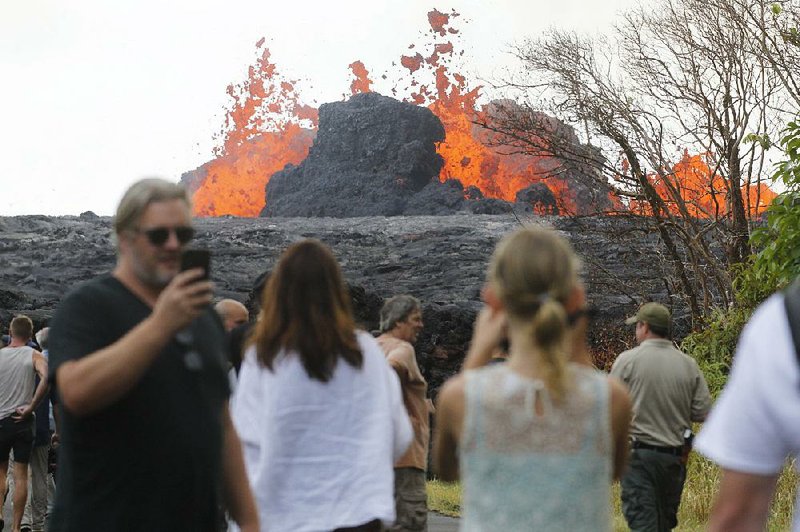HONOLULU -- Lava from the Kilauea volcano oozed over two wells at a geothermal power plant on Hawaii's Big Island, but county officials said the flow has stopped.
Officials said there was no release of any dangerous hydrogen sulfide gas after lava crept over the plugged wells Sunday.
Some feared a breach if lava penetrated the well shafts that tap steam and hot water to make electricity. Both wells were closed and secured in anticipation of the lava flow.
The well had been plugged to protect against the release of gas that could turn toxic when mixed with lava.
David Mace, a spokesman for the Federal Emergency Management Agency, said the flow started about 200 yards away from the nearest well. But he said safety precautions went into effect before the breach.
Puna Geothermal, owned by Nevada's Ormat Technologies, was shut down shortly after Kilauea began spewing lava on May 3. The plant harnesses heat and steam from the Earth's core to spin turbines to generate power. A flammable gas called pentane is used as part of the process, though officials earlier this month removed 50,000 gallons of the gas from the plant to reduce the chance of explosions. They also capped the 11 wells at the property to try to prevent a breach.
Before the lava reached the well, plant spokesman Mike Kaleikini told the news agency Hawaii News Now that there was no indication of the release of the poisonous gas hydrogen sulfide -- the greatest fear should lava hit the wells.
"As long as conditions are safe, we will have personnel on site," Kaleikini said. "Primary concern is sulfur dioxide from the eruption and lava coming on site. We monitor for hydrogen sulfide and sulfur dioxide on a continuous basis."
Steve Brantley of the Hawaiian Volcano Observatory said the flow seemed to have halted Sunday morning before it picked back up and covered the well at the plant, which lies on the southeast flank of the volcano, nestled between residential neighborhoods.
Lava-filled fissures have torn apart chunks of the southeastern side of the Big Island over the past three weeks as Kilaeau has become more active.
The volcano has had it all over the past three weeks: molten rock shooting toward the sky, lava oozing from the ground and ash clouds rising miles into the air.
You can also add "vog" to the mix.
Scientists say higher sulfur dioxide emissions recorded at the volcano's vents in recent days are creating the potential for heavier than usual vog, or volcanic smog. So far, trade winds have been mostly blowing the gray haze offshore.
Volcanic smog, or air pollution, is created by vapor, carbon dioxide and sulfur dioxide gas released from Kilauea. It reacts in the atmosphere with oxygen, sunlight, moisture and other gases and particles. In a matter of hours or days, it converts to fine particles that scatter sunlight, creating a haze that can be seen downwind of Kilauea, according to The Interagency Vog Dashboard, which is made up of Hawaii, U.S. and international agencies.
The U.S. Geological Survey said sulfur dioxide emissions from the volcano have more than doubled since the current eruption began.
Kilauea was belching 15,000 tons of the gas each day, up from 6,000 tons daily prior to the eruption. People living miles from the eruption are paying attention to the amount of noxious fumes pouring out of the volcano because it creates potential for more vog.
"Everyone is having symptoms now on some level," said Dr. Josh Green, a state senator and emergency room physician who has been volunteering in communities where lava fissures have opened in neighborhoods.
Symptoms for generally healthy people can include burning eyes, headaches and sore throats. But those with asthma or other respiratory problems can end up hospitalized.
Those who are healthy, physically active and don't smoke can usually tolerate basic symptoms, Green said, adding hospitals are seeing more patients with difficulty breathing.
Green's mom, Natasha Green, who lives on the Kona side of the island, said the vog was particularly bad on Tuesday. "It makes it very hard to breathe," she said, adding that her other symptoms include coughing and watery and stinging eyes.
She's had to use an inhaler, which she doesn't need when there isn't vog. She's a former smoker, "so that's probably part of the problem," she said.
Information for this article was contributed by Jennifer Sinco Kelleher, Audrey McAvoy and Sophia Yan of The Associated Press.
A Section on 05/29/2018
